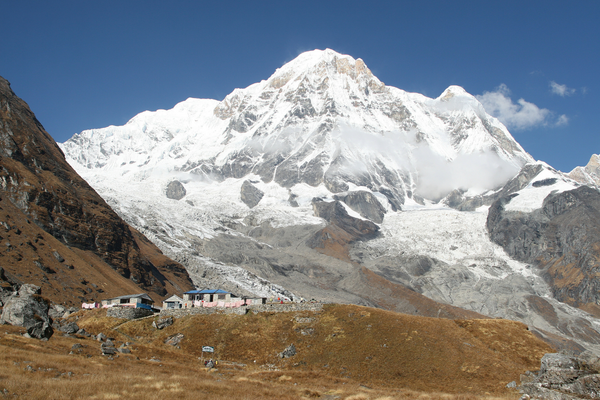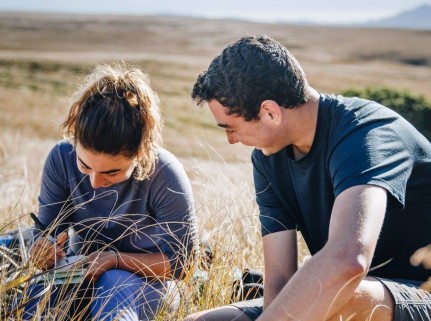What does it really look like trekking in the Himalayas?
We are thrilled to announce we have just released a combined India and Nepal Semester Program. These exotic sounding countries conjure images of monasteries, the towering Himalayas, the Taj Mahal, mountains of spices and colorful fabrics. Nepal won’t just be trekking; it will also involve grassroots homestays, yoga at a buddhist monastery and a safari in Chitwan National Park. After several weeks of travel, we jump into Incredible India to see the Taj Mahal, go Bollywood dancing, work alongside rehabilitated sloth bears, take on a surf camp and cruise the Kerala backwaters. This is the most culturally diverse program we have on offer.
However, lots of students are asking the same question; what does it look like trekking in the Himalayas? Here’s an evocative snapshot to give you more of an idea of what you would be in for.
The Annapurna Base Camp is a world away from Kathmandu. In the city of Kathmandu, the streets come alive mid morning with hunks of meat strung up on hooks on butcher street, flower garlands are nimbly thread as offerings around the temples, clothing and vegetables are piled and stacked high to sell and locals crowd around frying pans for deep dried doughy snacks. Out in the mountains, life moves slowly. In fact, our guides love to say ‘Bistari! Bistari! / Slowly, Slowly!

Wafting cinnamon smoke, frazzle-haired golden highland cows, prayer flags eternally flapping in the wind, handmade copper bowls overflowing with offerings, bunches of bells strung together on fences, silhouettes of religious stupas decorating every high point, timeless waterfalls that have carved trenches into vertical rock walls and gold threads of light knit together the morning sky. There's no place on earth with more drama, yet no worries. There are dramatic snow peaks layered in impossibly thick slabs of hard packed glacial ice. There are hawks and kites gliding over the Annapurna ranges, seemingly never flapping their wings.
Each morning we leave early and arrive after lunch. The afternoons are filled with card games, riddles, reading, journaling. As we hike higher, we take it ever so slowly, avoiding the chance of altitude sickness. We also walk slowly because this region is surreal. There are cobble stoned villages stuck in ancient times to greet us along the way. Tibetan mountain dogs sit poised on stone walls and smile knowingly as we click clack with walking poles into town. Scruffy yaks with dreadlocked tails navigate cobble stones with nothing else on their mind. In some towns, monkeys climb through bars to pull the lids off simmering pots and are scolded like children from the cooks. Prayer wheels snake their way around temples, and we have to walk around clockwise, rolling the decorated metal with our palm as we go.
Zig zagging with the track, the view on both sides somehow increases the heart rate even more. The vertical drop from the carved path leads to the raging blue river below. Layers of pine covered rock slabs remind us of North America, but the brain bogglingly high snowy mountains are more dramatic. At the highest points on the trek we sit down to eat chocolate bars and digestive biscuits, in awe of the all round mountain view; tiny villages perched way above us amongst impossible sheer rock peaks, farming plots in unbelievable locations and the strength it must take to bring all of the materials up here to make living possible. The snowy mountains look close enough to reach out and touch; long waterfalls frozen in time and haggard walking tracks pattern the land. Sometimes we pass people with huge loads, 160 pound loads of plywood or a stack of mattresses on their back. Everything for the guest houses and the villages needs to be delivered on foot.
Our lives are comfortable on the Base Camp trek. Our bellies are full of buffalo milk chai, popcorn, dry fried curry potatoes, apple pie, a bit of yak here and there, buckwheat chapati and an array of other starchy carbohydrates. Our eyes are full of crisp blue skies and fresh views around every corner of the deep, winding gorges we follow. We hardly glance in a mirror; we shower every few days and hand wash our socks and undies when needed. Porters help carry our gear; We couldn’t spend so much time enjoying ourselves if it weren't for their help.
We are all excited to return to civilization and shower away 12 days worth of beanie wearing, wind blown, dirt stained hair. The lakeside town of Pokhara is filled with good food, laundromats for our dirty clothes and ‘trekking remedy' massages. Fresh socks never felt so good! We will have a big dinner with the porters and guides and everyone who helped us achieve this amazing feat, sharing chicken curry and saying our farewells.
Hiking in the Himalayas is really famous for good reason. The mountains help us to realize how tiny we are in the world. The ancient glacial valleys remind us how insignificant we are on the calendar of time. The people live in remote and challenging places, yet they come across so humble and serene. These are great lessons for putting things in perspective. Hiking out here is indeed a challenge, but oh so worth it. What might your aha moment be out there?
Learn more about our Nepal and India Gap Semester Program here.

Leave a Comment
Your email address will not be published. Required fields are marked *